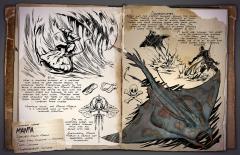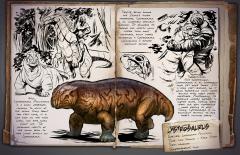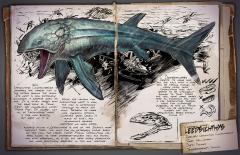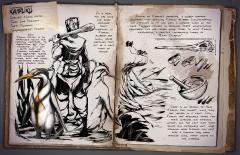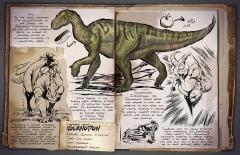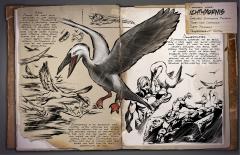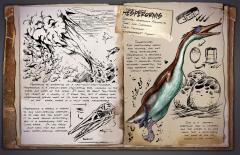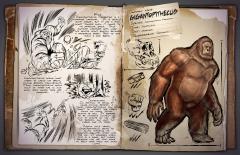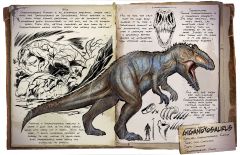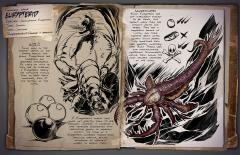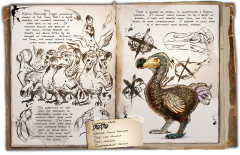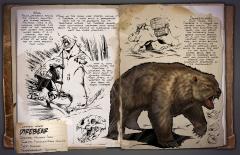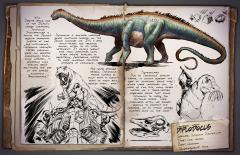-
Posts
15,571 -
Joined
-
Last visited
-
Days Won
93
Content Type
Profiles
Forums
Calendar
Gallery
ARK News
Sponsored Mods
ARK Mobile News
Everything posted by Jatheish
-
From the album: Dossiers
Common Name: Megaloceros Species: Megaloceros Latuscoronam Time: Pliocene Diet: Herbivore Temperament: Skittish Wild: Megaloceros Latuscoronam is a very skittish herbivore, found mostly in the forests and mountains of the island. Because of its large size, its fraught demeanor would be strange in any other place. But Megaloceros knows how fierce the predators of the island are, and knows that it is safer to flee from them than to risk its life in a fight. The horns of Megaloceros are very large, and make for an excellent source of Keratin. This, of course, makes it a valuable resource. Unfortunately, hunting Megaloceros is not easy because of their quick speed and ability to bound over most obstacles. Domesticated: Megaloceros is a jack-of-all-trades creature, and many who ride it value its versatility. It is decently powerful, and its resilience, speed, and ability to jump often come in handy. Finally, its charging horn attack tends to cause targets to "bleed", decreasing their health, stamina, and speed until healed!-
- megaloceros
- deer
- (and 9 more)
-
From the album: Dossiers
Common Name: Manta Species: Manta Mobula Time: Early Oligocene - Holocene Diet: Carnivore Temperament: Defensive Wild: Here is another example of a creature that seems to have evolved beyond its historical traits. Everything points to this being a saltwater ray, but Manta Mobula has developed the ability to swim into the island´s rivers and shallows, as well as through the open ocean. Perhaps there were originally two types of ray on the island before, but years of interbreeding combined their lineage. Normally docile, the Manta Mobula is a carnivore only in that it consumes Plankton. Its tail is incredibly sharp, and can pierce through thick hide and armor with ease. Fortunately, Manta Mobula is usually not aggressive, unless encouraged. Domesticated: While not the fastest swimmer around the island, Manta Mobula is the deadliest of small ocean mounts, and can be ridden bare-back. Tribes who value striking power over speed often keep large schools of Manta to ride. Its capability to briefly leap out of water provides it a showy tactic for avoiding combat as well. A quick jab through the heart onto an unsuspecting survivor can easily take them by surprise. Thusly, many tribes use it as an escort for their slower cargo-carrying swimmers. -
From the album: Dossiers
Common Name: Mammoth Species: Mammuthus steincaput Time: Early Pliocene Diet: Herbivore Temperament: Docile Wild: Seeing the likes of Mammuthus steincaput alongside dinosaurs is still strange. This behemoth towers over most creatures on the island, and does not seem to fear anything but the Tyrannosaurus. Mammoths generally thrive in colder areas and have a herd mentality. I'm honestly not certain how the herds of Mammoths find enough plant life to graze on some of the islands mountains. They must spend much of their time traveling between the mountains' cold summit and more lush base. Or maybe the Mammoth herd are the main reason the summits are so barren. Domesticated: Mammuthus steincaput is a difficult beast to domesticate. Not because they are inherently stubborn, but because knocking one out to begin the taming process takes forever. Once tamed, however, Mammoths are one of the only creatures on the island that can uproot trees without shattering them. -
From the album: Dossiers
Common Name: Lystrosaurus Species: Lystrosaurus amicifidelis Time: Late Permian - Early Triassic Diet: Herbivore Temperament: Loyal Wild: Lystrosaurus aicifidelis is a small herbivore, common to much of the island. Only about two feet long, it is not high on the food chain, and eats small plant life. The poisonous insects of the island seem to have little effect on Lystrosaurus. Despite being among the Island's tinier herbivores, Lystrosaurus is an incredibly resilient survivor. It recovers its torpor and health much faster than most creatures, which makes rendering a Lystrosaurus unconscious a rather difficult affair. Domesticated: Not surprisingly, Lystrosaurus is an extremely loyal pet once tamed. It's a very fast learner, so it gains experience much more quickly than most other creatures. Additionally, its presence nearby appears to inspire allies, making them learn and gain experience more rapidly as well. Thusly, Lystrosaurus is an excellent addition to any tribe's hunting party.- 1 comment
-
- lystrosaurus
- synapsid
-
(and 6 more)
Tagged with:
-
From the album: Dossiers
Common Name: Liopleurodon Species: Liopleurodon Magicus Time: Mid-Late Jurassic Diet: Carnivore Temperament: Patient Wild: Liopleurodon Magicus is a mid-sized ocean predator. Typically between 20 and 25 feet long, it mostly hides within the reefs, waiting to ambush prey that swims by. Due to its low acceleration and medium speed, Liopleurodon tends not to chase prey that escape its initial devastating chomp attack. The species on the island almost seems, to be magical. The reptiles skin secretes an oil that, when absorbed through skin contact, makes the rider process oxygen more efficiently for extreme diving. When traveling the ocean for resources Liopleurodon will show you the way. Domesticated: Neither the fastest swimmer, nor the most powerful ocean predator, Liopleurodon still has its uses for those wanting to stay underwater for extended periods of time. Many tribes use Liopleurodon for long duration oil-and-oyster harvesting trips. Often, those who don't believe in the Liopleurodons qualities are shunned.- 1 comment
-
- liopleurodon
- water
- (and 7 more)
-
From the album: Dossiers
Common Name: Leedsichthys Species: Leedsichthys Conviviumbrosia Time: Mid-Jurassic Diet: Piscivore Temperament: Defensive Wild: Leedsichthys Conviviumbrosia is probably the largest fish in the waters around the island. Its meant is also extremely succulent, a surprise given its size. It is often traded with the same value as Prime Meat, and colloquially called ‘Prime Fish’. Of course, not all of Leedsichthys’ meat is this high quality but most of it is! While the demand for Leedsichthys meat is high, the fish is notoriously difficult to track and hunt. Between its large size, powerful attacks, incredible speed (when it turns to flee), and humankind’s general ineptitude on open water, actually killing a Leedsichthys is one of the island’s more difficult tasks. The hunt for an extremely elusive breed of the fish, the fabled ‘Great Albino’ Leedsichthys has been known to drive otherwise-sensible men and women mad with obsession, as if all evil were visibly personified and made practically assailable in this one creature. Domesticated: Despite its large size, and the fact that it may well be strong enough to carry heavy loads, Leedsichthys does not appear to be intelligent enough to tame. Nevertheless, some large tribes keep an enormous pen with a few Leedsichthys trapped inside for cultivating purposes, as bits of prime fish can be repeatedly scraped off the gargantuan beast without killing it.-
- leedsichthys
- fish
- (and 7 more)
-
From the album: Dossiers
Common Name: Kaprosuchus Species: Kaprosuchus Paludentium Time: Late Cretaceous Diet: Carnivore Temperament: Aggressive Wild: A smaller relative of the Sarcosuchus, Kaprosuchus Paludentium is water-based carnivore primarily found lurking among The Island's swamps. A naturally fast runner that is even faster in the water, it is a solitary hunter that picks off small-to-medium creatures especially those isolated from their pack. When attacking Kaprosuchus uses two main tactics. First, it patiently waits below the water surface and when the target is sufficiently close by, will perform a lateral jump that it uses to quickly close the distance with its prey and drag it underwater. Secondly, its attacks target the prey's vital areas specifically to drain its stamina. These two techniques effectively prevent most creatures from escaping Kaprosuchus once an assault has begun. Domesticated: Survivors are generally split about the usefulness of Kaprosuchus. Some love its speed both in and out of the water, essentially making it among the fastest small-sized all-terrain mounts when travelling through the wetlands. Others do not like how relatively frail Kaprosuchus is, and do not think its high speed and damaging attacks make up for this shortcoming.- 1 comment
-
- kaprosuchus
- late cretaceous
-
(and 6 more)
Tagged with:
-
From the album: Dossiers
Common Name: Kairuku Species: Kairuku waitaki Time: Late Paleogene Diet: Piscivore Temperament: Friendly Wild: Kairuku Waitaki is an amazingly docile and friendly creature, to everything but fish. Honestly, I'm not quite sure how Kairuku manages to stay populated across the islands colder climates, with the many predators stalking these frozen lands. It is weak, and only one small defensive trait: suspended in Kairuku blubber are small, dense particles that act as a light form of armor. Adding to Kairuku's problems, a clever survivor discovered that refining Kairuku blubber (concentrating the particles in it) can yield a natural form of the same Polymer utilized in advanced tribes' manufacturing processes. This has caused many tribes to hunt Kairuku extensively, a practice colloquially known as "Kairu Clubbing". Domesticated: There is no reason to tame Kairuku for combat since they are useless in a fight. Still, Kairuku are regularly tamed for their cuteness and friendly nature, and the fact that their bodies run extremely hot. Just standing near Kairuku can help keep a survivor stay warm through long, harsh nights on the icebergs.-
- penguin clubbing
- organic polymer
- (and 10 more)
-
From the album: Dossiers
Common Name: Iguanodon Species: Iguanodon vicissitudinis Time: Late Jurassic Diet: Herbivore Temperament: Reactive Wild: Of the many creatures I've yet encountered the island, the Iguanodon vicissitudinis has the distinctly versatile ability to change its primary method of locomotion according to its momentary needs. While bipedal, it can employ rapid stabbing attacks with its distinctive thumb spikes. In quadrupedal stance, conversely, it seems to have an endless supply of stamina, even while sprinting! Primarily a rather lethargic quadrupedal herbivore native to the island's many grasslands and forests, in situations where increased speed or maneuverability is called for, it will quickly shift its posture into bipedal stance and behave like a very different creature! Domesticated: Interestingly, the Iguanodon's thumb spikes also provide it with the capability to pick seeds out of fruits, allowing a farmer to handily convert stacks of fruits into stacks of seed for planting. Combined with its highly effective fruit harvesting and substantial carry weight, the Iguanodon's excellent mobility in bipedal stance makes it an ideal field-hand that can also pull off a quick get-away, or an agile defense, when needed. -
From the album: Dossiers
Common Name: Ichthy Species: Ichthyosaurus curiosa Time: Late Triassic - Early Jurassic Diet: Carnivore Temperament: Curious Wild: Ichthyosaurus curiosa is a comparatively small carnivore found in the waters around the island. It is slightly larger than a human, but that’s still small compared to the leviathans roaming these waters. It seems to be very interested in any creature around its size, often approaching and following humans swimming through its waters. Despite its appearance, the Ichthyosaurus is neither a fish nor an ocean mammal. Like many creatures in the waters around the island, it is actually an aquatic reptile. Domesticated: I can’t think of a better mount for someone starting to explore the island’s seas and waterways. Ichthyosaurus is comparatively fast swimmer, and even in the wild will cozy right up to you and try to figure out what you’re doing. Taming these is actually pretty easy, as they seem to love humans and will be fed and tamed without the use of violence.-
- ichthy
- ichthyosaurus
- (and 10 more)
-
From the album: Dossiers
Common Name: Ichthyornis Species: Ichthyornis piscoquus Time: Late Cretaceous Diet: Piscivore Temperament: Skittish Wild: Among the most vocal creatures on the island, Ichthyornis Piscoquus is actually a relatively normal seagull. Living near the beaches, it primarily eats fish, and its distinctive cries can be heard echoing over literally every beach across the island. As you might expect from a seagull, Ichthyornis will flee at the slightest provocation. Ichthyornis is an excellent fish hunter, often catching and killing small-to-medium fish in one attack. Its primary method of predation is to dive into the top layers of water and impale or bite its prey. When looking for fish,Ichthyornis will often just fly in circles over the water and wait for its next opportunity to dine. Domesticated: Ichthyornis surprised me by being a very loyal and social creature, once tamed. It likes to ride on its owner's shoulder, and bring that person treats (in the form of fish, of course) which its beak-grip enhances with extra healing vitamins. The personality of Ichthyornis reminds me of a housecat hauling a dead lizard back to its family, except bringing extra-healthy fish instead.-
- ichthyornis
- bird
- (and 7 more)
-
From the album: Dossiers
Common Name: Hesperornis Species: Hesperornis Avenatantes Time: Late Cretaceous Diet: Piscivore Temperament: Flippant Wild: Appearing as something of a half-duck-half-dinosaur, Hesperornis is a medium-sized fish-eating bird, common in the rivers and lakes os the island. It would be about two-thirds the height of a human, if it stood tall, but it rarely does. Hesperornis spends most of its time gliding along the surface of the water, where it is much more maneuverable. Hesperornis is barely a threat to any land-dwelling creature, as its legs are too short for it to move around effectively, but it is a surprisingly fast on the water. It can easily hunt down fish and other small water-dwelling creatures. Domesticated: Not particularly useful for hunting, and not being affectionate, Hesperornis is primarily kept for the specialized eggs it produces. When rendered correctly, the eggs separate into two distinct substances: One is a protein substance high in calories, and the other is an oily liquid that is effectively the same as the oil found in the ocean!- 1 comment
-
- hesperornis
- flippant
-
(and 6 more)
Tagged with:
-
From the album: Dossiers
Common Name: Gigantopithecus Species: Gigantopithecus fibrarator Time: Pleistocene Diet: Herbivore Temperament: Territorial Wild: Gigantopithecus fibrarator is a strange creature. It is usually quite passive, but it has a very short temper when it comes to its personal space. Once another creature gets close, this gentle giant quickly becomes a rampaging beast. Best to give them a wide berth. Gigantopithecus seems most happy to lazily lay about, picking berries from plants. Many Gigantopithecus spend much of their day in one small area unless they are provoked. Domesticated: In addition to being at home picking berries a tamed Gigantopithecus can be taught to harvest the fibers found on many island plants as well. It appears to be entirely content to pick at plants all day, eat the berries, and hold the fibers for its tribe. Playful once tamed, Gigantopithecus seems to enjoy throwing its shoulder-mounted rider into the air. It probably feels this is a game, but clever brigands can use this "game" to vault over walls and small cliffs.-
- gigantopithecus
- ape
-
(and 8 more)
Tagged with:
-
From the album: Dossiers
Common Name: Giganotosaurus Species: Giganotosaurus Furiosa Time: Late Cretaceous Diet: Carnivore Temperament: Angry Wild: Giganotosaurus Furiosa is an enormous predator, larger even than the Tyrannosaurus or Spinosaurus. While greater in size than those storied predators, it can be somewhat less dangerous when encountered in the wild, due to its sluggish speed. Even still, getting cornered or run down by a Giganotosaurus means certain death for nearly creature! Fighting a Giganotosaurus directly is never a good idea, as its rage rapidly grows with every hit it takes. With this rage, it builds increasing reserves of energy to use, making its iron jawed bites progressively more deadly and enhancing stamina. Add to this the fact that its huge body enables it to take a tremendous amount of punishment, and you have a creature that is generally better avoided or outsmarted than attacked head-on. Domesticated: Taming Giganotosaurus is a dangerous prospect. Its rage reaction even when tamed, can sometimes cause it to briefly turn of its own tribe. Indeed it may even throw off its rider is it has been angered! And yet, The sheer size and immense power that the Giganotosaurus possesses means that some factions endeavor to tame it as a fear-inducing "Captal" beast of war even at great risk!-
- giganotosaurus
- giganot
-
(and 8 more)
Tagged with:
-
From the album: Dossiers
Common Name: Gallimimus Species: Gallimimus evolvelox Time: Late Cretaceous Period Diet: Herbivore Temperament: Skittish Wild: When someone asks me what the fastest creatures on the island are, Gallimimus is always a contender. Unlike the island's many armored animals, Gallimimus eschews strong defenses for the ability to outrun pretty much anything. A skittish herbivore, Gallimimus even looks nervous when eating in a peaceful clear meadow. Having no real way to harm predators, it simply runs away and uses its ability to stay safe. I've even seen wild Gallimimusoutrun speed-trained Utahraptors! Domesticated: There are two general camps on the use of tamed Gallimimus. One camp thinks that their inability to actually harm hostile creatures, and their inability to harvest most resources, makes them primarily a burden to the tribe. The other camp thinks that their extreme speed and ability to jump long distances is among the best for scouting and exploring... or just making a quick getaway!-
- gallimimus
- tameable
-
(and 5 more)
Tagged with:
-
From the album: Dossiers
Common Name: Eurypterid Species: Jaekelopterus Euryperus Time: Silurian Diet: Carnivore Temperament: Aggressive if approached Wild: Found only in the deepest depths of the waters around the island, Eurypterids are dangerous and adaptable Arthropods. As likely to hunt as they are to scavenge, a Eurypterid rarely has difficulty finding food to keep itself nourished, even at the bottom of the ocean. A Eurypterid’s threat does comes not directly from its raw strength. Instead, it combines a hard defensive exoskeleton with debilitating poison to powerful effect. The sting of a Eurypterid increases torpor while reducing stamina, quickly rendering its opponent unable to defend itself. Domesticated: While Eurypterid are not intelligent enough to be tamed, this doesn't mean they are without utility for tribes. They are a wonderful source of Chitin, and their digestive tract often contain Silica Pearls. They sometimes even have incredibly rare Black Pearls used for manufacturing mysterious technologies, making them among the most valuable creatures on the island.-
- eurypterid
- invertebrate
- (and 7 more)
-
From the album: Dossiers
Common Name: Electrophorus Species: Electrophorus Beluadomito Time: Holocene Diet: Carnivore Temperament: Reactive Wild: Occupying a space in the low-to-middle end of the food chain, Electrophorus beluadomito is a carnivorous swimmer that feeds mostly off of shellfish and small fish. Despite its common name, it is actually a very long knifefish, and not an eel. It does not provide much meat, so many predators simply leave it be. Unlike most predators, it does not use brute strength to bring down its prey, but instead releases an electrical charge around itself to knock its prey unconscious. Alone, this can take out a small creature. When attacking together, Electrophorus can even bring down the larger ocean lifeforms, then feed as a group. Domesticated: By far, the most common use of Electrophorus is to subdue large ocean creatures. Knocking out a Plesiosaur or other giant deep-sea leviathan can be incredibly difficult, thus many tribes employ small schools of Electrophorusto shock targets into submission! -
From the album: Dossiers
Common Name: Dunkleosteus Species: Dunkleosteus Loricaruptor Time: Late Devonian Diet: Carnivore Temperament: Aggressive Wild: Dunkleosteus Loricaruptor is a very strange creature. It is a fairly large fish, covered head to tail in armored plates, with incredibly powerful jaws. It tends to eat the islands' water-dwelling crustaceans, as it not fast enough to catch most of the smaller fish. Dunkleosteus is a surprisingly combat-oriented for a fish. Its well-armored body protects it from many creatures, while its bite is strong enough to easily crush through chitinous shells. Domesticated: Dunkleosteus is an incredibly useful fish for coastal communities. Its powerful jaws make short work of the stone and oil formations found throughout the oceanic depths. While harvesting, Dunkleosteus can handily defend its rider from all but the largest threats in the waters. And once past its prime, the Dunkleosteus can be harvested for a fair amount of Chitin.-
- dunkleosteus
- fish
-
(and 6 more)
Tagged with:
-
From the album: Dossiers
Common Name: Doedicurus Species: Doedicurus custosaxum Time: Plestiocene – Holocene Diet: Herbivore Temperament: Docile Wild: Doedicurus custosaxum is one of the island’s non-aggressive herbivores, generally found on mountains and grasslands. Large and well-armored, it has a supply of fat under its plates to keep it warm and fed in the cold. Doedicurus has adapted well to the dangers of the island, perhaps even better than the Ankylosaurus. Doedicurus has two very different reactions to predators. Against smaller foes, it generally uses its spiked tail to inflict as much damage as possible. Against larger predators, however, it pulls its tail underneath itself to form a solid armored ball that is nearly impossible for creatures to pierce. Domesticated: Doedicurus is a highly prized work animal on the island. Its spiked Tail is ideal for quickly shattering the large rocks, so Doedicurus is a very efficient quarry worker. And in case their quarry gets raided, Doedicurus-Riders have a very difficult-to-kill mount!-
- doedicurus
- doed
-
(and 9 more)
Tagged with:
-
From the album: Dossiers
Common Name: Dodo Species: Raphus replicare Time: Late Holocene Diet: Herbivore Temperament: Oblivious Wild: Raphus replicare (more commonly known as the Dodo Bird) is quite possibly the dumbest creature I've ever seen in my life. It wanders around the beaches of the island, eating berries off bushes and being eaten by all manner of carnivore. Without the Dodo the whole Island's food chain would disintegrate. This subspecies of the Dodo has developed an unbelievably clever way to sustain itself: they mate constantly. I'm fairly convinced that they reach full maturity within a week of being born. This is the only trait keeping them populous on the island. Domesticated: There is almost no reason to domesticate a Raphus replicare. It cannot carry enough to be a beast of burden, it does not provide much food, and it's too stupid to show companionship. I suppose it could work as a last-ditch food source, though. -
From the album: Dossiers
Common Name: Direwolf Species: Canis Maxdirus Time: Pleistocene Diet: Carnivore Temperament: Aggressive Wild: The best adjective to describe Canis Maxdirus is "scary". This pack-hunter is a cunning and brutal predator, capable of taking down prey of nearly any size. In addition to being a vicious hunter, it is the size of a small horse, meaning even the largest predators aren't necessarily safe from the packs. The species has an incredible affinity for teamwork. Unlike most creatures on the island, Canis is a dedicated pack hunter, and rarely hunts alone. In fact, Canis is naturally as effective with its packmates as most creatures are when their mate is in danger—when in a pack, they are naturally spurred to fight for their lives. Furthermore, when in a pack, the most experienced Canis will be designated "Alpha" and gain an even stronger enhancement. Domesticated: Obviously, Canis is an amazing battle mount. It is fairly fast, very strong, and agile. It can jump almost as well as the Island's battle cats. Riding a supercharged "Alpha" Canis into battle at the head of a bloodthirsty pack is a thrill for which most warriors would gladly proclaim: "Today is a good day to die!" -
From the album: Dossiers
Common Name: Direbear Species: Arctodus Dirus Time: Mid Pleistocene / Early Holocene Diet: Omnivore Temperament: Territorial Wild: Found primarily among the Island’s mountain and tundra regions, Arctodus Dirus is an imposing creature. Like most of the creatures, that inhabit this island’s colder areas, it is a mammal, and this particular mammal is either at or near the top of that region’s food chain. Many on the island have started calling it Direbear, a name which appropriate both due to it’s enormity and it’s territorial nature. The Direbear ignores most non-hostile creatures while going about its daily routine of scavenging for meat and edible plantlife... That is, until intruders enter the territory it considers its own, at which point it viciously attacks. Most often, it is smartest to just run from an angry Direbear. Domesticated: Once tamed, the Direbear is a strong and reliable mount. it can carry vast quantities of goods, and can sprint for extremely long, nearly infinite periods. It is not the fastest creature from a hard stop, but after building up momentum, its sustained overland speed builds to among the best on the island. Of course, being able to feed a Direbear both meat and plantlife makes keeping one fairly convenient regardless of the environment. -
From the album: Dossiers
Common Name: Diplodocus Species: Diplodocus Insulaprincep Time: Late Jurassic Diet: Herbivore Temperament: Naive Wild: Despite being one of the Island's larger creatures, Diplodocus Insulaprincep is among the Island's smaller sauropods. Instead of the size and intelligence, Diplodocus developed faster maximum speed and greater endurance. When fully matured, it generally only reaches about two-thirds the size of the rather enormous Brontosaurus. Diplodocus is another creature whose continued survival on the Island confuses me. It's a very thick-headed and trusting animal, often to its fatal detriment. It usually doesn't flee from predators until after they've attacked it repeatedly, preferring instead to make numerous fruitless attempts at friendship. For some strange reason, Diplodocus trusts humans so much that it doesn't seem to fight back against them... ever! Domesticated: Due to Diplodocus' smaller frame, it cannot support the type of 'platform' saddle that other large creatures can. To make up for this, many tribes instead use a three-seater passenger saddle that allows Diplodocus to carry two additional riders. These passengers often use ranged weapons to protect the creature, or to attack nearby enemies while on the move!-
- diplodocus
- dinosaur
-
(and 7 more)
Tagged with:


